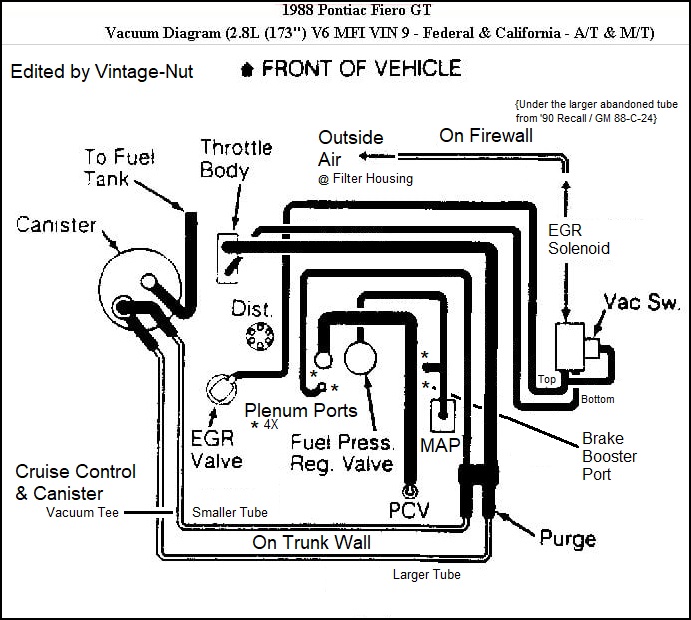 
     |
| Code 35 (Page 1/1) |

|
Yellow-88
|
JUL 16, 11:35 AM
|
|
Hello
Is it possible to have a high idle and no code 35?
|
|

|
theogre
|
JUL 16, 02:49 PM
|
|
|
Often an vac leak will do just that & don't set other codes too. ------------------
Dr. Ian Malcolm: Yeah, but your scientists were so preoccupied with whether or not they could, they didn't stop to think if they should.
(Jurassic Park)
The Ogre's Fiero Cave
|
|

|
cartercarbaficionado
|
JUL 16, 02:50 PM
|
|
|
yes. an idle of 2k constant may or may not set the code in my experience on 3 fieros now. it seems like there's quite a few ways they can raise the idle too high with that the ecm will ignore
|
|

|
Vintage-Nut
|
JUL 16, 03:29 PM
|
|
| quote | theogre:
Often an vac leak will do just that & don't set other codes too. |
|
Vacuum leaks are the first area to double check that you're VERY SURE you don't have issues on the lines.....

The second often area with a high idle is a faulty engine coolant temperature sensor for the ECM (GM 25036979 for V6)
Many members had reported that this sensor was their high idle problem.....------------------
Original Owner of a Silver '88 GT
Under 'Production Refurbishment' @ 136k Miles
|
|

|
Yellow-88
|
JUL 16, 04:40 PM
|
|
Thank you.
I've seen high idle a few times but never a code 35.
Right now I'm idling at 1100 -1400.
No vac leaks verified by blocking the IAC inlet. Immediate stall.
It seems like most codes do require more than one parameter to set. Apparently code 35 is one of them.
The book hints that MAP and TPS are involved in code 35.
I do like the temp sensor idea. Is there a way to test in situ before I replace it?
On Vacuum leaks, an excellent test tool is a hiss tube. That's a small diameter tube attached to a plastic tube you stick in your ear.
Unlike a stethoscope, it hears tiny air or exhaust leaks.
|
|

|
Vintage-Nut
|
JUL 16, 06:53 PM
|
|
| quote | Yellow-88:
I do like the temp sensor idea. Is there a way to test in situ before I replace it? |
|
The only way to test the sensor is to remove it and put it a pan of heated water.

To me, I replaced the majority of my sensors in my 'Production Refurbishment' as they're ~36 years old.
| quote | | On Vacuum leaks, an excellent test tool is... |
|
I tested all of my vacuum lines with a hand operated vacuum pump and gauge:
Remove one end of the vacuum line and block it with a rubber cap
Remove the other end of the vacuum line and put the hand operated vacuum pump
Pump the line to ~20Hg and wait 5 minutes to see if the line leaks.......
|
|

|
Yellow-88
|
JUL 16, 10:38 PM
|
|
| quote | Originally posted by Vintage-Nut:
I tested all of my vacuum lines with a hand operated vacuum pump and gauge:
Remove one end of the vacuum line and block it with a rubber cap
Remove the other end of the vacuum line and put the hand operated vacuum pump
Pump the line to ~20Hg and wait 5 minutes to see if the line leaks.......
|
|
Thank you, great data.
Yes, that is a proper test for a vacuum tube. What do you see in your testing of "aged" tubes?
They seem to be some serious polymer.
|
|

|
theogre
|
JUL 17, 07:46 AM
|
|
| quote | Originally posted by Vintage-Nut:
The only way to test the sensor is to remove it and put it a pan of heated water.
 |
|
This like many other "temp charts" have errors also claim is same data for All sender/sensors & Is Not.
This one is made by who knows & some fields don't match or ignore GM Publish Data for ECT or MAT/ACT. See https://web.archive.org/web...fierocave/ecmqrg.htm that data direct from Fiero FSM.
Is completely wrong for dash temp gauge sender. see https://www.fiero.nl/forum/...HTML/146784.html#p11 that data direct from Fiero FSM. This sender is about same format but NTC resistor has different resistance curve to work better w/ the dumb gauge.
|
|
    
  |















